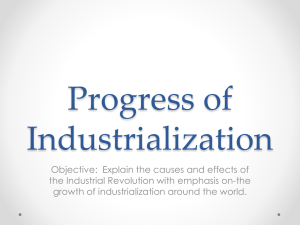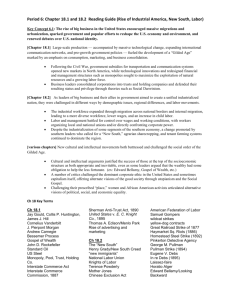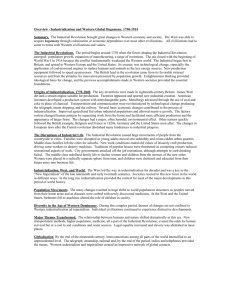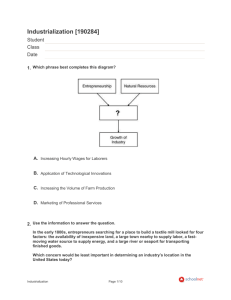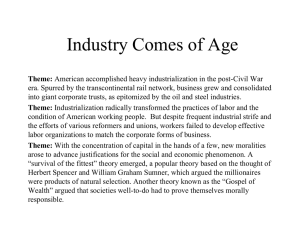US Multiple Choice Questions: Industrialization
advertisement
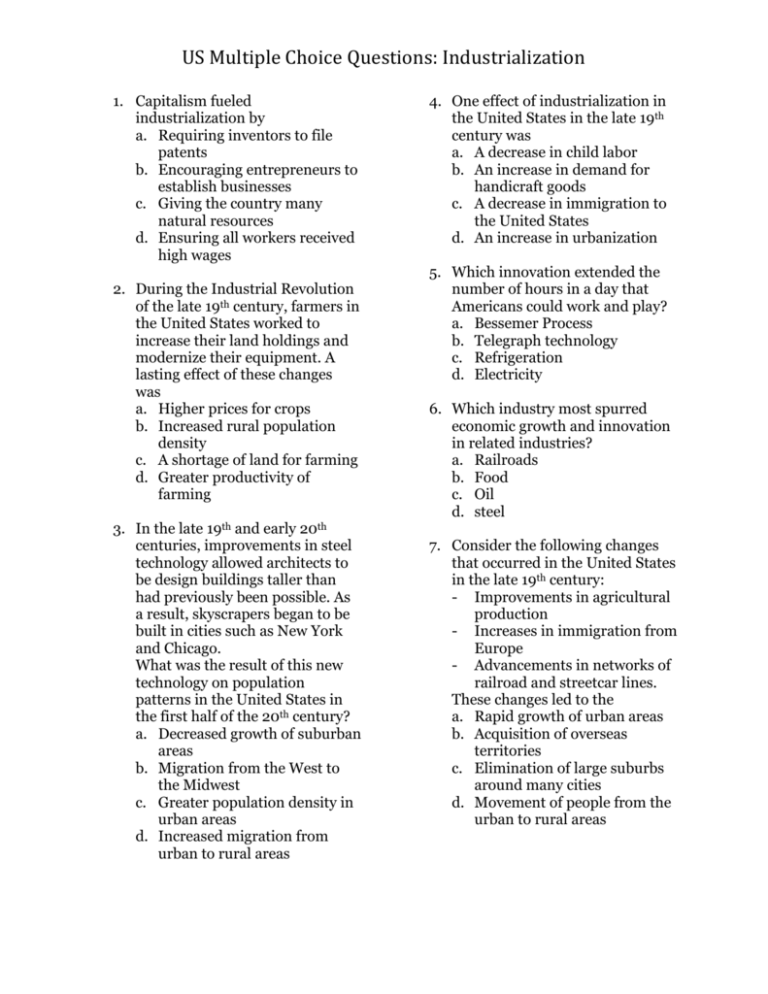
US Multiple Choice Questions: Industrialization 1. Capitalism fueled industrialization by a. Requiring inventors to file patents b. Encouraging entrepreneurs to establish businesses c. Giving the country many natural resources d. Ensuring all workers received high wages 2. During the Industrial Revolution of the late 19th century, farmers in the United States worked to increase their land holdings and modernize their equipment. A lasting effect of these changes was a. Higher prices for crops b. Increased rural population density c. A shortage of land for farming d. Greater productivity of farming 3. In the late 19th and early 20th centuries, improvements in steel technology allowed architects to be design buildings taller than had previously been possible. As a result, skyscrapers began to be built in cities such as New York and Chicago. What was the result of this new technology on population patterns in the United States in the first half of the 20th century? a. Decreased growth of suburban areas b. Migration from the West to the Midwest c. Greater population density in urban areas d. Increased migration from urban to rural areas 4. One effect of industrialization in the United States in the late 19th century was a. A decrease in child labor b. An increase in demand for handicraft goods c. A decrease in immigration to the United States d. An increase in urbanization 5. Which innovation extended the number of hours in a day that Americans could work and play? a. Bessemer Process b. Telegraph technology c. Refrigeration d. Electricity 6. Which industry most spurred economic growth and innovation in related industries? a. Railroads b. Food c. Oil d. steel 7. Consider the following changes that occurred in the United States in the late 19th century: - Improvements in agricultural production - Increases in immigration from Europe - Advancements in networks of railroad and streetcar lines. These changes led to the a. Rapid growth of urban areas b. Acquisition of overseas territories c. Elimination of large suburbs around many cities d. Movement of people from the urban to rural areas US Multiple Choice Questions: Industrialization 8. Why was the formation of labor unions an effect of U.S. industrialization in the late 1800s? a. Union were needed to guarantee a steady supply of workers b. Union membership was required for employment in new industries c. Factory owners set up labor unions in order to control their large workforce d. Unions organized industrial workers to protest unsafe working conditions and long workdays. 9. The economic development of the United States between 1870 and 1950 helped produce the results shown in the above graph. The trend shown in the graph is associated with a. Increased urbanization b. Decreased immigration c. Advances in communication d. Reduced population growth 10. As farms became mechanized, a. Immigrants bought more land b. More people become farmers c. Farmers moved to urban areas d. Farm workers became rural entrepreneurs 11. What problem arising from U.S. industrialization did the progressive reformers of the late 19th and early 20th centuries want the federal government to address? a. Use of child labor in the workplace b. Unfair taxes on the wealthy c. Restrictions on the use of natural resources d. Lack of capital for railroad expansion 12. In the late 19th century, industrialization led to harsh working conditions in the United States. Which policies of the U.S. government allowed such conditions to develop and later led to the growth of labor unions to correct abuses of workers? a. Laissez faire policies toward big business b. Antitrust policies toward monopolies c. Imperialist policies regarding territorial expansion d. Isolationist policies regarding international alliance US Multiple Choice Questions: Industrialization 13. As a result of industrialization in the United States in the late 19th and early 20th centuries, progressive reformers sought government regulation of business in order to a. Control economic cycles of inflation and recession b. Provide money for public services such as schools and libraries c. Restore competition by limiting the power of monopolies and trusts d. Prevent companies from moving their factories to other countries 14. What effect of 19th century industrialization in the United States is represented by the changes shown in the above graph? a. Increased regulation of child labor b. Modernization of agriculture c. Decreased demand for farm products d. Emigration from the United States 15. The appearance in many U.S. cities of department stores, organized sporting events, musical theaters and amusement parks in the last decades of the 19th century was evidence of what effect of industrialization? a. Improved working conditions on American farms b. The growing power of unions to negotiate benefits for their members c. Government-sponsored programs to improve public health and education d. An increase in the leisure time and disposable income of the urban middle class 16. Consider the following changes that occurred in the United States in the late 19th century: - Increases in immigration - Widespread industrialization - Improvements in agricultural technology What was one result of these developments during this time period? a. The growth of large cities b. The decline of labor unions c. The spread of plantation agriculture d. The construction of interstate highways US Multiple Choice Questions: Industrialization 17. In 1770 James Hargreaves of England received a patent for his spinning jenny. Another Englishman, Samuel Crompton, combined the spinning jenny with a water frame. He called his new invention the spinning mule. The spinning jenny and spinning mule are examples of a. Cultural changes b. Socioeconomic changes c. Technological advances d. Communication advances 19. Railroads brought goods and people to America’s trade and manufacturing centers. Chicago grew as a meatpacking city. Philadelphia became a manufacturing center for steel and coal. New York grew as a thriving center for trade. Increased industrialization led to a. Improved sanitation and housing b. The elimination of the working class c. Improvements in the lifestyle of the working class d. An increase in the number of people working in manufacturing 20. Corporations had the important advantage of a. Being run by an individual or family b. Developing into monopolies c. Reducing the financial risk for individual investors d. Keeping prices high 18. What is the meaning of the cartoon? a. The children need food b. The children need new clothes c. Capitalists cared about child welfare d. Children are being treated as property 21. Which argument supports the perception of big business leaders as “Captains of Industry”? a. Industrialists support for technology benefited the economy b. Monopolies forced small companies out of business c. Consumers were harmed by inflated prices d. Workers’ wages rose as industrialists profited US Multiple Choice Questions: Industrialization 22. In the late 1800s, workers tolerated poor wages because they a. Thought that the government would protect them b. Believed it had to get worse before it got better c. Could be replaced easily by other workers d. Were tricked by employers into taking dangerous jobs. 26. How did federal government support employers during labor unrest? a. Called on the Pinkertons to stop strikes b. Denied unions recognition as legally protected groups c. Imprisoned Eugene Debs and other labor leaders for life d. Made company towns illegal 23. Which labor leader began the AFL? a. Samuel Gompers b. Terence Powderly c. Eugene Debs d. Uriah Smith Stephens 27. As part of the garment industry, adults and children worked in small, crowded rooms called sweatshops making new clothes. Their hours were long. Their pay was little. Often the rooms were dark. What advantage were sweatshops to the textile industry? a. They eliminated textile factories b. They kept the cost of production low c. They employed only women and children d. They helped families create their own small businesses 24. What was one result of the Haymarket Riot? a. Steelworkers’ wages increased b. Public support for unions grew. c. The AFL ceased to exist d. Membership in the Knights of Labor declined 25. Labor unions formed as a way to help workers a. Find better jobs b. Learn more skilled trades c. Improve their working conditions d. Increase the hours children could work 28. Industrialization affected the United Sates a. Through the growth of urban cities b. By encouraging westward movement c. Through the growth of small family farms d. By emigration from the United States to Europe US Multiple Choice Questions: Industrialization 29. In his article The Gospel of Wealth, Andrew Carnegie stated, “The contrast between the palace of the millionaire and the cottage of the laborer with us to-day…is not to be deplored, but welcomed as highly beneficial. It is…essential for the progress of the race.” Andrew Carnegie a. Believed in equality b. Promoted regulation of industry as a means to wealth c. Felt a class system was essential d. Believed that everyone should receive the same opportunities 30. Government attempted to regulate business a. Through the Keating-Owen Act b. Through the Sherman Antitrust Act c. By calling for the establishment of monopolies d. By forcing railroads to create a fair pricing structure 31. Labor unions grew in response to unregulated working conditions. Why, then, did strikes, such as the Homestead Steel Strike in 1892, result in a loss of support for organized labor? a. The strikes turned violent b. Immigrants refused to join labor unions c. Management agreed to better working conditions d. Labor unions banded together to form one large labor union 32. In 1906 Congress passed the Meat Inspection Act and the Federal Food and Drugs Act. Both laws were in response to industry practices exposed by a. Muckrakers b. Political machines c. Corrupt politicians d. Company presidents 33. The Industrial Revolution began in which country? a. France b. Great Britain c. Japan d. The United States 34. Which was the first industry impacted by the Industrial Revolution? a. Automobile b. Electrical appliances c. Steel d. Textile 35. Which of the following was NOT an effect of the Industrial Revolution? a. An increasing number of people worked in factories b. An increasing number of people lived in cities c. An increasing number of people worked on family farms d. An increasing number of people left the family farms US Multiple Choice Questions: Industrialization 36. Industrialization in the United States resulted in a. Politics not being affected by the economic changes b. Workers seeing no need to unite to form labor unions c. The transformation from an urban to an agrarian (farming) society d. The country becoming more urban than rural 37. Which group of people made up the majority of immigrants to America before 1870? a. European protestants b. Scandinavian Catholics c. Chinese Buddhists d. South American Jews 38. Which of these factors pulled immigrants to the United States? a. Lack of food b. Religious persecution c. Poor economic conditions d. Potential employment 39. Which of the following was an important effect of nineteenthcentury industrialization on American society? a. An increase in the number of small farms b. A decline in international trade c. A lowering of the prices of many manufactured goods d. A decline in the economic power of the middle class 40. As the inventions and methods of the Industrial Revolution spread around the world, they brought many important changes. What was an important effect of industrialization in the United States? a. A decline in the size of the middle class b. A decline in the use of laborsaving technologies c. An increase in migration from the countryside to the cities d. An increase in the demand for hand-made goods “It was a town of red brick, or of brick that would have been red if the smoke and ashes had allowed it; but as matters stood it was a town of unnatural red and black like the painted face of a savage. It was a town of machinery and tall chimneys, out of which endless smoke trailed forever and ever. It had a black canal in it, and a river that ran purple with ill-smelling dye.” 41. This is a quotation from the novel Hard Times, by Charles Dickens. The condition of the town described in this passage illustrates the effects of the a. Enlightenment b. American Revolution c. Industrial Revolution d. French Revolution US Multiple Choice Questions: Industrialization 42. Why was industrialization in the United States primarily concentrated in the Northeast? a. This region had the greatest supplies of capital and labor. b. The climate of the North favored industrial development. c. Other regions of the country lacked water transportation. d. The Midwest and South had fewer natural resources. 43. One objective of middle class reformers, such as Progressives in the United States, was to a. Overthrow capitalist governments through violent revolution b. Liberate colonial areas in Africa and Asia from imperialist rule c. Curb the worst abuses of industrialization by government regulation d. Limit the powers of absolute rulers by introducing democratic reforms “Crouched over the coal chutes, the boys sit hour after hour, picking out the pieces of slate. I once tried to do the work a twelve-year old boy was doing day after day, for ten hours at a stretch, for sixty cents a day. The gloom appalled me.” - John Spargo 44. What development did the conditions described in this quotation lead to? a. Passage of child labor laws b. Ideas of the Enlightenment c. Spread of imperialism to Africa d. A migration from the countryside to cities 45. Which of the following societal changes was brought on by the Industrial Revolution? a. Coal miners moved out of the cities b. Rural folk moved to cities for factory jobs c. Farm wives gained a valuable source of income d. Seamstresses were promoted to management positions 46. Cities had been built on rivers from the very beginning of human civilization. When the Industrial Revolution began, growing cities were often located close to what other resource? a. Farmland b. Oil wells c. Child labor d. Coal and iron mines 47. The major feature of industrial cities in Britain was a growing population. How did population growth affect these industrial cities? a. Population growth created more jobs b. Population growth resulted in more schools c. Population growth encouraged migration to rural areas d. Population growth led to overcrowded, unsanitary living conditions US Multiple Choice Questions: Industrialization 48. At processing stations, officials met with immigrants to determine their medical condition and a. Legal standing b. Religious preferences c. Educational level d. Political beliefs 49. Certain conditions workers faced in growing industries led them to form labor unions. Which of the following conditions was most responsible for the growth of unions? a. Long hours and low wages in industry b. Women in the workforce c. Lack of skilled jobs in factories d. Violence in the workplace 50. Industrialization began in northeastern Europe, but later spread to the rest of the world. This expansion was the result of a. Improved transportation b. Better working conditions c. A ban on child labor d. Reliance on a family-based economy 51. Which of the following provided Americanization programs for new immigrants? a. Congress b. Settlement houses c. Ghettoes d. Trade unions 52. The first reliable streetcars were powered by a. Electricity b. Coal c. Animals d. Gasoline 53. Most Midwestern cities were established near a. Mountains b. Water c. Skyscrapers d. Manufacturing plants 54. Zoning laws were designed primarily to a. Encourage growth of heavy industry b. Separate functions within a city c. Create immigrant ghettoes d. Protect water from pollutants 55. Even though unlit city streets were dangerous, a. Most city planners did nothing about it b. Professional police officers refused to patrol them c. Factory workers had to travel to and from work in the dark d. City governments rejected electric streetlights 56. The middle-class lifestyle of the Gilded Age featured a. A return to classical ideals b. A reflection of rural values c. A new emphasis on acquiring goods d. Renewed interest in controlling journalists 57. Consumption patterns were most influenced by a. Advertising b. Transportation c. New educational theories d. Special-interest newspapers US Multiple Choice Questions: Industrialization 58. After the Civil War, the cost of living decreased because a. Consumers wanted imported goods b. Sanitation and medical care improved c. Men took public transportation to work d. Technology made manufacturing more efficient 62. ____________ believed that society was a competition in which the fittest came out on top, which justified the inequality handed to immigrants and minorities during the Gilded Age. a. Socialists b. Social Darwinists c. Transcendentalists d. Union Leaders 59. Factors that lead to the urbanization of America - Millions of new factory jobs due to industrialization - Growth of the Railroad Network - ??? 63. The 189os brought about a significant rise in legal racism (especially in the South), known as— a. Social Darwinism b. Containment c. The Niagara Movement d. Jim Crow Laws Which of the following factors should be added to the list above? a. Dollar diplomacy b. Women’s suffrage c. The Spanish-American War d. Influx of immigrants 60. Which of these encouraged industrialization to move from the eastern part of the United States to the West? a. Subways b. Labor Unions c. Muckrakers d. Railroads 61. In addition to championing Prohibition and women’s suffrage, the Progressive Party called for an end to--a. Direct elections b. Child Labor c. Labor Unions d. Unregulated immigration -Debt and high interest rates -Value of product decreased due to record yields - Inflated prices of manufactured goods - High prices for railroad use 64. Despite the benefits brought by new technology and machinery, _______ suffered financially in the late 19th century due to the issues above. a. Importers b. Industrialists c. Farmers d. Miners 65. Long working hours, low pay, and unsafe factory conditions gave rise to--a. Labor unions b. Dollar diplomacy c. Child labor d. Trust-busters US Multiple Choice Questions: Industrialization - Discrimination - Language barriers -??? 66. The difficulties above were experienced by immigrants in America during the era 18771898. Which of the following items should be added to the list? a. Denied suffrage b. Slum living conditions c. Limited job availability d. High income tax 67. Which of the following statements is true about organized labor? a. The Supreme Court supported organized labor around the turn of the century. b. Immigrants contributed greatly to organized labor. c. Organized labor enjoyed the support of state governments d. Organized labor had great success changing working hours in the 1890s. 68. How did the government encourage growth of big business after the Civil War? a. By eliminating the tariff on foreign goods entering the U.S. b. By extending massive loans to business owners. c. By limiting immigration into the United States d. By following laissez faire policy of minimal regulation -The ability to sell stock -Limited liability for the owners -Improved ability to raise large sums of money 69. Industrialization changed the structure of business in America. The items above are all benefits of a. Corporations b. Unionization c. Proprietorships d. Monopolies 70. Hull House was founded in Chicago by Jane Addams to a. Help persecuted Jewish Americans b. Provide lodging for child laborers c. Help the urban poor living in slums d. Serve as a meeting place for suffragists 71. Which of the following was a muckraker during the Industrial Revolution? a. Jane Addams b. Upton Sinclair c. Woodrow Wilsom d. All of the above 72. Why are women attracted to the Progressive Movement? a. Lack of opportunities available to them b. Opportunity to influence social change c. Both of the above d. None of the above 73. Which of the following reforms did Progressives NOT focus on? a. Limit working hours b. Improve workplace safety c. Set minimum wages d. Establish unions US Multiple Choice Questions: Industrialization 74. These were people who expressed anti-immigrant sentiment and supported policies which favored native born Americans. a. Nativists b. Muckrakers c. Industrialists d. Racists 75. He founded the American Federation of Labor. a. Samuel Gompers b. Upton Sinclair c. Lincoln Steffens d. Woodrow Wilson


